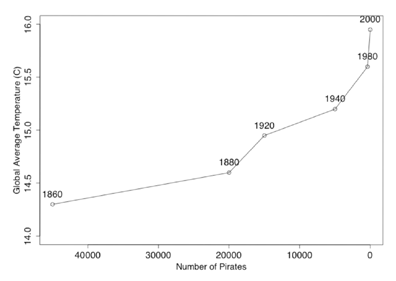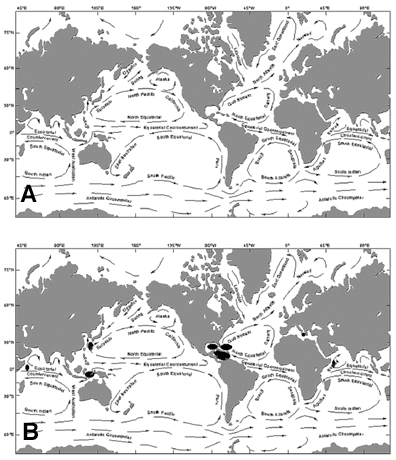PIRACY AS A PREVENTOR OF TROPICAL CYCLONES
ABSTRACT:
Recent hurricane seasons have been characterized by intense and frequent tropical cyclones. One contributor is increased sea-surface temperature, which is caused by decreased upwelling of cold deep-ocean water. We demonstrate that decreased pirate activity results in less upwelling. This suggests that the only viable solution to intense tropical cyclones is to increase pirate activity.
INTRODUCTION:
The destructiveness of the 2004 and 2005 hurricane seasons has heightened public and scientific awareness of the possible long-term consequences of global warming. Although the link between hurricane strength and global warming remains speculative, recent work has shown that hurricanes have intensified over the past 30 years (Emmanuel, 2005), with an increase in the number of category 4 and 5 hurricanes and a decrease in those classified as categories 1 and 2 (Webster et al., 2005). Emmanuel (1987) argued that hurricane intensity is a function of the sea surface temperature (SST) which, of course, increases as the Earth warms. But other factors are important as well. Lighthill et al. (1994) pointed out that while a lower SST limit of 26oC is required for tropical cyclone formation, several other key factors contribute to formation and intensity.
The increase in global average temperature is well-correlated with a decrease in global pirate population, as evident in figure 1 (Henderson, 2006).

We propose that piracy decreases the average SST, thereby lowering average global temperature and suppressing tropical cyclone intensity.
PIRACY AND UPWELLING:
Piracy decreases average SST by inducing upwelling of cold deep-ocean water. Various pirate activities contribute to upwelling. These include involuntary crew resignation, inter-vessel interactions and acoustically-transmitted oscillations (Bligh, 1789; Stevenson, 1883).
Involuntary crew resignation (ICR, a.k.a. “walking the plank”) involves a pirate or captive being forcibly ejected from a vessel at sea. This results in upwelling from displacement of water by the ejectee (Archimedes, c.250 BCE).
Inter-vessel interactions (IVI, a.k.a. “sea combat”) consists of transmission of projectiles between vessels, resulting in destruction or boarding. Upwelling is caused by scattered projectiles and by sinking of vessel elements.
Acoustically-transmitted oscillations (ATO, a.k.a. “sea shanties”) were originally intended to boost morale of rowing pirates. They have assumed ritual functions with the ascent of external power supplies. ATO’s produce upwelling by disturbing the sea surface. This increases motion of large biological entities (“fish” or “whales”), producing displacement.
MODEL RESULTS:
We have modeled pirate-induced upwelling using the PARROT (Piratic Activity Realization Rate of Oceanic Tendencies) oceanic circulation model (Haqq-Misra et.al. 2006). This model has 0.5o resolution and accurately reproduces present-day ocean currents (Figure 2a.).
We simulated normalized pirate-induced upwelling (in upwelling pirate units, or upu) over the three upwelling categories described above. An ICR event produces 1 upu. IVI’s produce a variable number of upu. We used a Maxwellian with an average of 1000 upu. It should be noted that IVI events can produce multiple ICR’s. ATO produces continuous upwelling, based on the local pirate density and oceanic biotic activity. The world average ATO is about 0.5 upu/day.
We average pirate activity from 1605-2005 for each ocean grid cell. While recent pirate activity is weak and concentrated off of the Somali coast (BBC, 2005), historically piracy has been concentrated in the Caribbean (Bruckheimer, 2003). This is consistent with our model results, which produce significant pirate-induced upwelling in the Atlantic basin (Figure 2b.).

DISCUSSION:
We have demonstrated that pirate activity produces upwelling. It is thus obvious that a decreasing pirate population will result in less oceanic upwelling, especially in the Atlantic basin.
As evidenced by the 2004 and 2005 hurricane seasons, decreased upwelling results in increased SST’s and more intense tropical cyclones. Our PARROT model predicts that if the downward trend in piracy continues tropical cyclones will intensify. The hurricane season may also lengthen, due to increased SST.
PREDICTIONS AND EXPERIMENT:
The PARROT model has not been experimentally verified. Therefore, we have predicted the upwelling and global impact resulting from a single ICR event. While the effects of an ICR event depend on the mass of ejectee, our model predicts a reduction of roughly 10% in the number of named tropical storms in the Atlantic basin in the 2006 season as a result of a relatively small ICR event off the northern Puerto Rican coast between March 9 and March 13, 2006.
We intend to experimentally verify PARROT by producing such an ICR event. At least one of the authors of this paper will be present for the experiment, to measure the exact upu value of the event.
CONCLUSIONS:
We have demonstrated that decreased piracy contributes to increased tropical cyclone intensity. The only viable solution is to increase pirate activity, especially in the Atlantic basin. We suggest that ICR’s and ATO are preferable to IVI’s, because they offer finer control of upwelling effects.
ACKNOWLEDGEMENTS:
We thank the Flying Spaghetti Monster for inspiring this work and Robert Henderson for advocating piracy to fight global climate change.
REFERENCES:
Archimedes (of Syracuse), On Floating Bodies, c.250 BCE, Syracuse, Greece.
Bligh, W., 1789. Log of the H.M.S. Bounty, Royal Navy, London, UK.
British Broadcasting Corporation, Nov. 25, 2005 “US Firm to Fight Somali Pirates”, London, UK.
Bruckheimer, J., 2003, Pirates of the Caribbean, Disney Enterprises, Orlando, FL, USA.
Emanuel, K.A., 1987. The Dependence of Hurricane Intensity on Climate, Nature, 326, 483-485.
Emanuel, K.A., 2005. Increasing Destructiveness of Tropical Cyclones over the past 30 years. Nature, 436, 686-688
Henderson, R. 2006, The Gospel of the Flying Spaghetti Monster, Villard.
Haqq-Misra, J.D., et al. 2006. A Predictive Ocean Circulation Model, in press.
Lighthill, J. et al., 1994, Tropical Cyclones and Global Climate Change, BAMS, 75, 2147-2157.
Stevenson, R.L. 1883. Treasure Island, Cassell & Co., London, UK